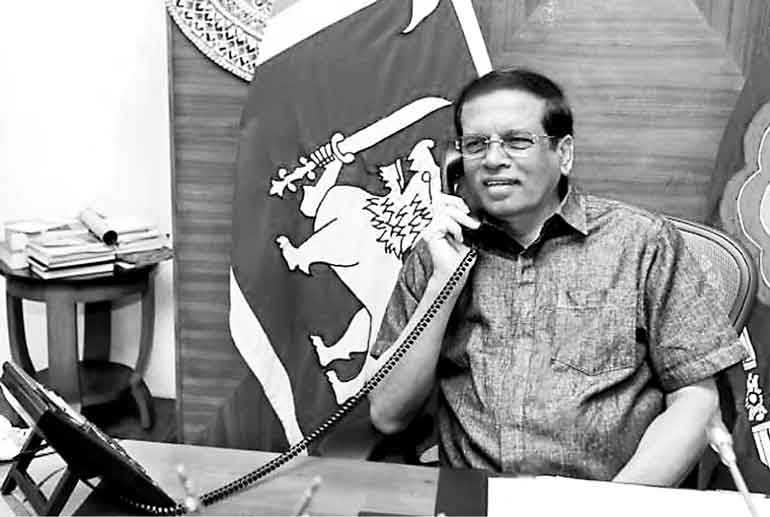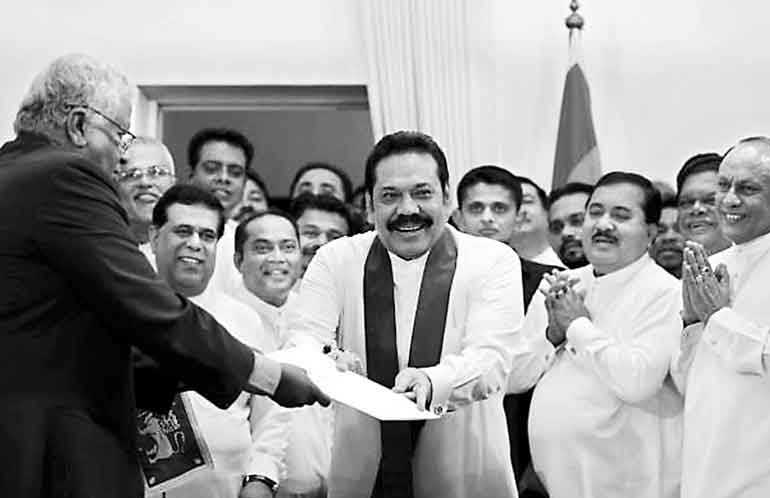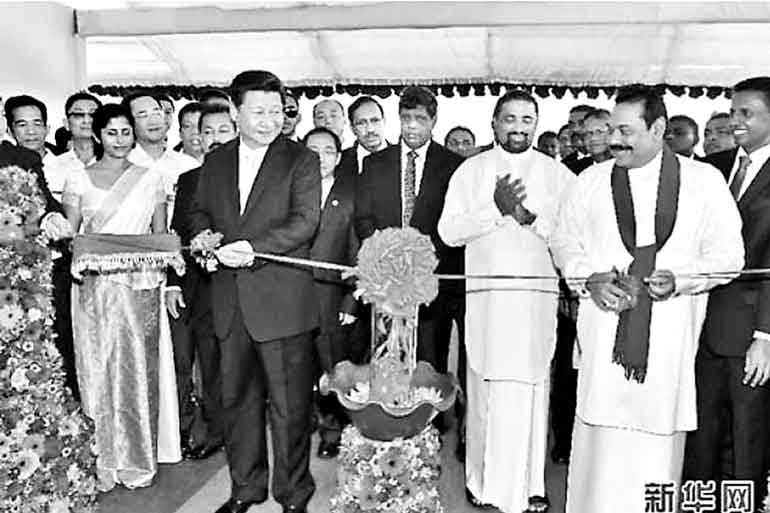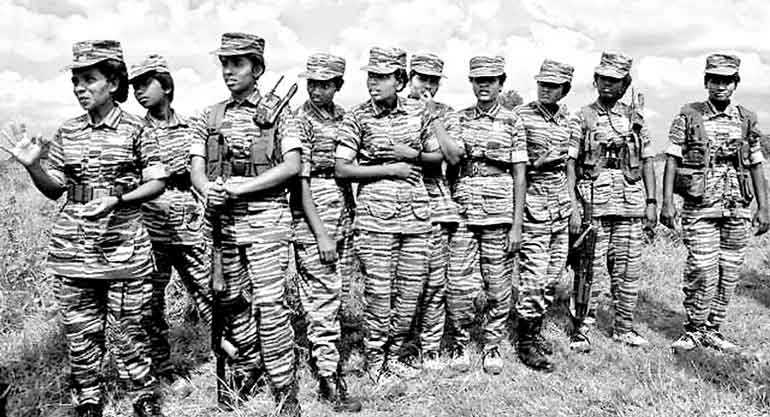Thursday Feb 13, 2025
Thursday Feb 13, 2025
Saturday, 3 November 2018 00:10 - - {{hitsCtrl.values.hits}}

President Maithripala Sirisena in a phone conversation with Indian Prime Minister Narendra Modi, on 17 October – Photograph: @MaithripalaS/Twitter)

Prime Minister Mahinda Rajapaksa hands over inaugural documents to an official during his duties assuming ceremony in Colombo, Sri Lanka, on 29 October – Photograph: AP/PTI

Chinese President Xi Jinping, accompanied by then President Mahinda Rajapaksa, inspected the South Container Terminal of Colombo Port, on 17 September 2014 – Photograph: Chinese Ministry of Foreign Affairs
By Sreeram Chaulia
BloombergQuint: The crisis unleashed in Sri Lanka by President Maithripala Sirisena’s sacking of Prime Minister Ranil Wickremesinghe, and the unexpected comeback of former President Mahinda Rajapaksa, reflects deep underlying flaws in a country struggling to transition from authoritarianism to democracy and from war to peace.
Pure dirty politics
Seen through the prism of individual protagonists, the constitutional deadlock and head-spinning cloak-and-dagger manoeuvres by former allies turned foes turned renewed friends – Sirisena and Rajapaksa – reveal how devious politicians are in this volatile Indian Ocean island.
Betrayal of trust, backstabbing, and opportunism are, of course, part and parcel of competitive politics in many parts of the world. But these negative traits have been carried to an extreme cutthroat level in Sri Lanka where respect for institutions and consensus about how the country should be governed have gone for a toss.
Sirisena saw the writing on the wall when his party fared badly in local body elections in February 2018.
Sensing that his own political ambitions of running for a second term as president would be doomed if he remains stuck in a coalition with a Prime Minister like Wickremesinghe whose popularity was declining, he switched sides and hitched his wagon to an ascendant Rajapaksa.
Lurid tales of an assassination plot against the President where the Prime Minister was allegedly complicit suggest that Wickremesinghe, or some of his aides, were also desperate to survive using any means available. None of the three main sides in this ruthless scramble for power bothered for constitutional propriety, the mandate of voters or the global image of the country.
The authoritarian bug
Undoubtedly, the principal politicians are guilty of undermining constitutionalism and democratic norms.
But Sri Lanka has a structural legacy problem of an arbitrary and authoritarian exercise of power that precedes Sirisena, Wickremesinghe, and Rajapaksa.
The concept of an ‘Executive Presidency’ since 1978 has vested excess concentration of power in the hands of strong-willed heads of state such as J.R. Jayewardene (1978-1989), Chandrika Kumaratunga (1994-2005) and Rajapaksa (2005-2015).
Accumulation of vast prerogatives in the hands of Presidents at the cost of Parliaments, Prime Ministers, and civil society has been challenged, most recently by Wickremesinghe through the Nineteenth Amendment to Sri Lanka’s fourth Constitution. But these attempts have run into stiff status quo-ist pushback from Presidents hailing from both the mainstream Sri Lankan political parties. One of the reasons why Wickremesinghe had to be booted out by Sirisena was that the former was backing a draft fifth Constitution that would introduce checks and balances against misuse of presidential authority.
Reforms toward liberalisation of Sri Lanka’s polity are essential for a more moderate and less autocratic form of state power to emerge.
The current climate of a ‘constitutional coup’ must be understood in terms of the lack of will and consensus about such an evolution.

Ethnic polarisation
The second core factor that led to the breakdown of the Sirisena-Wickremesinghe combine is the unresolved ethnic question and contestation over the makeup of the state between a unitary and a federal system.
Despite the crushing defeat of the separatist Liberation Tigers of Tamil Eelam through Rajapaksa’s no-holds-barred counter-insurgency in 2009, none of the leading Sinhalese political parties which have taken turns to rule since then have offered meaningful autonomy or justice for the war-ravaged Tamil and Muslim minorities of Sri Lanka.
Ideologically, Wickremesinghe’s United National Party is inclined to be magnanimous in post-war reconciliation and reconstruction wherein ethnic minorities develop a sense of equality and belonging to Sri Lanka. But over the last three years, Wickremesinghe could not fulfil expectations raised by his electoral promises. Inquiries into war crimes against Tamil civilians during the armed conflict have been stonewalled and the military still calls the shots in the North and East of the country with hardly any delegation of powers to local Tamil and Muslim elected representatives.
Calls from extremist politicians, military men, and Buddhist clerics to reject any tampering with Sri Lanka’s repressive unitary framework which privileges the central government and entrenches privileges for the ethnic majority Sinhalese have been so deafening and electorally potent that Wickremesinghe had to backtrack.
To boot, Sirisena played a sly game of posing as a liberal while fearing the wrath of hardline Buddhist fundamentalists if he genuinely joined hands with Wickremesinghe to change Sri Lanka’s ‘ethnocratic’ system where the Sinhalese Buddhists get first-class citizenship rights and minorities are subjugated.
Rajapaksa’s revived fortune today owes not only to the poor economic performance of the Wickremesinghe Government since 2015 but also to the lingering ethno-religious chauvinist tendency among conservative Sinhalese who see Rajapaksa as their saviour against a liberal multicultural future.
The foreign hands
Much of the international attention during Sri Lanka’s current crisis has fallen on the geopolitical rivalry between India and China and how the two Asian giants are aligned with different local sides in Sri Lankan politics.
The Rajapaksa camp’s critique that Wickremesinghe was parceling out prime infrastructural assets to India and turning Sri Lanka into a ‘sub-colony’ of India rehashes a conspiratorial drumbeat of right-wing Sinhalese nationalists for decades. This charge is factually wrong because Wickremesinghe had actually upset India by delaying many of its proposed developmental projects in Sri Lanka.
Despite the hard rightist portrayals in Sri Lanka of Wickremesinghe as a ‘pro-India’ politician, he hobnobbed with China and sought Chinese investments in Sri Lanka. In some instances, even if he wanted to favour and award infrastructure deals to India, Sirisena is believed to have used his overarching presidential control over foreign policymaking to stay the Prime Minister’s hand.
Given the rapid shifts in alignments and policy positions, one interesting possibility is that Rajapaksa has also swivelled since the days when he was a blatantly pro-China politician. His September 2018 visit to India, meeting with Modi, and assurances that his vision is for an “inclusive” Sri Lanka that understands India’s ‘special concerns’ convey that all is not lost for India as it looks on at the island’s troubles with concern.
Moreover, if Rajapaksa does finagle a parliamentary majority and his pairing with Sirisena works out this time, the former will be quite constrained this time as Prime Minister compared to the era when he himself was President and abused power like a dictator. Security and foreign policy authority vests with the office of the President rather than the Prime Minister in the current Sri Lankan Constitution which looks set to remain in place due to Wickremesinghe’s ouster.
India will, therefore, continue to engage closely with Sirisena to protect its strategic interests, while trying to further encourage Rajapaksa’s possible mellowing down and sobering transformation.

Women fighters of the Liberation Tigers of Tamil Eelam stand on the rebel side of a border crossing in Omanthai in North-Central Sri Lanka on 15 February 2002
A quest for democracy and equality
The question of whether India or China wins or loses from the latest shake-up in Sri Lankan politics is not just crucial to strategists in New Delhi, Beijing, and Washington. It also matters to ordinary Sri Lankan people. The real issue is how India and China figure in the context of the two big domestic structural impediments bedeviling Sri Lanka – authoritarianism and majoritarianism.
As a stable and evolved democracy with a successful integration of linguistic and religious minorities, India is the template that Sri Lanka should aspire to emulate.
China, on the other hand, prefers a centralised, hard authoritarian Sri Lanka like what was witnessed when Rajapaksa was President and his police state committed rampant human rights violations.
If Sri Lanka has to break out of the vicious cycle of political instability derived from its abusive and discriminatory state structure, only closeness to India can prod it in a progressive direction. As to the economic benefits which China brings with its deep pockets, it is apparent to most Sri Lankans that they are already caught in a ‘debt trap’ and in danger of ending up in servitude to Beijing.
To paraphrase Martin Luther King, the arc of Sri Lanka’s moral universe is long, but it ultimately must bend towards India.
(Source https://www.bloombergquint.com/opinion/sri-lanka-crisis-a-failure-of-institution-building-and-nation-building#gs.UYRQA04)
(Sreeram Chaulia is a professor and dean at the Jindal School of International Affairs in Sonipat, India. His most recent book is ‘Modi Doctrine: The Foreign Policy of India’s Prime Minister’. The views expressed here are those of the author, and do not necessarily represent the views of BloombergQuint or its Editorial team.)

Discover Kapruka, the leading online shopping platform in Sri Lanka, where you can conveniently send Gifts and Flowers to your loved ones for any event including Valentine ’s Day. Explore a wide range of popular Shopping Categories on Kapruka, including Toys, Groceries, Electronics, Birthday Cakes, Fruits, Chocolates, Flower Bouquets, Clothing, Watches, Lingerie, Gift Sets and Jewellery. Also if you’re interested in selling with Kapruka, Partner Central by Kapruka is the best solution to start with. Moreover, through Kapruka Global Shop, you can also enjoy the convenience of purchasing products from renowned platforms like Amazon and eBay and have them delivered to Sri Lanka.
Discover Kapruka, the leading online shopping platform in Sri Lanka, where you can conveniently send Gifts and Flowers to your loved ones for any event including Valentine ’s Day. Explore a wide range of popular Shopping Categories on Kapruka, including Toys, Groceries, Electronics, Birthday Cakes, Fruits, Chocolates, Flower Bouquets, Clothing, Watches, Lingerie, Gift Sets and Jewellery. Also if you’re interested in selling with Kapruka, Partner Central by Kapruka is the best solution to start with. Moreover, through Kapruka Global Shop, you can also enjoy the convenience of purchasing products from renowned platforms like Amazon and eBay and have them delivered to Sri Lanka.